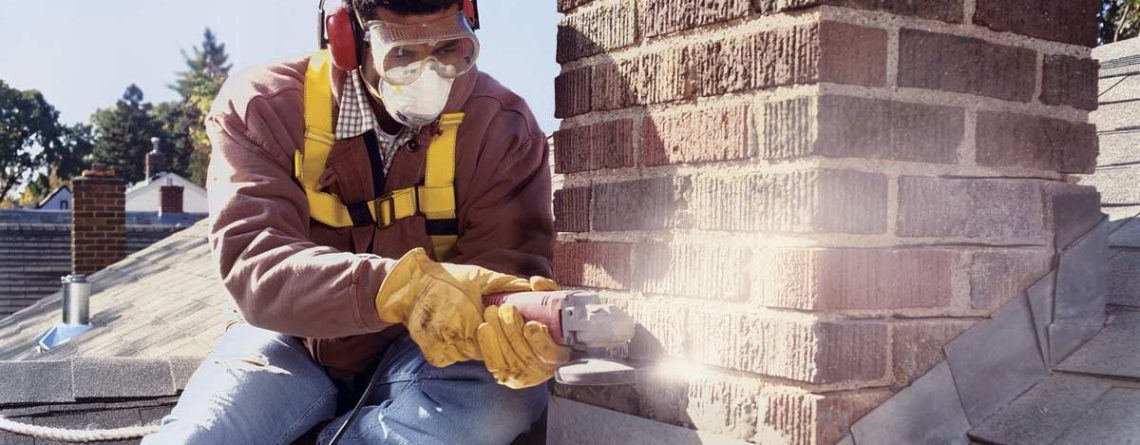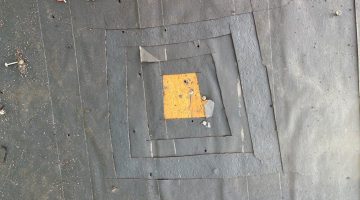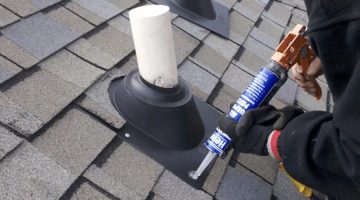Almost all chimneys will leak at some point in their lifetime. For homeowners, this can be discouraging, especially when they don’t know what is causing it. We’ll give you a hint: you might want to check your chimney flashing. In this post, we’ll be breaking down: How to identify broken chimney flashing How to repair chimney flashing When it’s time to call in a professional Sound interesting? Keep reading to learn more! What Is Chimney Flashing? chimney flashing up close shot If you’re not a chimney expert, it’s not unusual to have never heard of chimney flashing before. Essentially, chimney flashing works as a sort of waterproof seal. It is designed to help redirect water toward your rain gutters and keep it out of the chimney. Flashing is installed at the point where your roof meets your chimney and is typically made of aluminum or steel. Signs of Faulty Chimney Flashing Some signs of faulty or worn-down chimney flashing is easier to spot than others. If you’re wondering if it is time to repair your chimney flashing, here are some things to look out for. Leaking Chimney – For most people, a leaking chimney is the most common sign of broken flashing. Leaks indicate that water is seeping in past the seal. Water Stains – Are you noticing water stains or other signs of water damage on your ceiling and walls near your chimney? It could be a sign that water is getting in through your chimney. Rust Stains – If your existing chimney flashing is looking rusty, it may not be deflecting water as well as you want it to. Discolored Bricks – Is your chimney looking worn down and discolored? This could be a sign of a water-damaged chimney. Can I Repair My Own Chimney Flashing? If you are a thrifty homeowner, you may be wondering if you can install new flashing by yourself. The answer? Yes! Installing flashing requires some know-how and measuring, but it is doable as a DIY project. That being said, this is a repair designed to prevent water damage to your home. If you don’t feel 100% confident in your construction skillset, it is best to leave the repairs and replacement to a professional. After all, it’s not worth it to save money now if you end up spending more in the long run. How Much Does It Cost to Repair Chimney Flashing? Speaking of saving money, how much does it actually cost to repair or replace your chimney flashing? The good news is that, in the grand scheme of repairs, chimney flashing replacements are relatively affordable. Most homeowners can expect to spend between $700-$1500 on their chimney flashing repair when hiring a professional. If you go the DIY route, that cost becomes much smaller, averaging about $100-$200. This number will change based on the type of material you choose. What Tools Will I Need? Before you begin your chimney flashing repair, make sure that you have these tools on hand. Safety Harness Ladder Metal Flashing Caulk Tin Snips Measuring Tape Roofing nails Hammer Leven chimney flashing man repairing chimney 6 Steps For Repairing Chimney Flashing Ready to start your repairs? Follow these steps to get flashing that lasts.
1) Remove Old Flashing The first step is to remove the existing flashing to make way for the new pieces. You should be able to remove the flashing by using a pry bar. Use that same pry bar to scrape off any remaining pieces of roofing cement so that you can start with a clean surface.
2) Measure Your Roof Slope In order to ensure that your roof is installed properly, we recommend measuring the slope of your roof before starting. You can do this by laying a piece of scrap plywood onto your roof and measuring the run and the rise with your level. Connect those two lines and measure the length of the “rise” line to determine your slope.
3) Cut New Flashing Once you have determined your roof slope, it is time to cut your new flashing. We like to make sure that our base flashing and step flashing are cut appropriately and ready to go for an easy installation.
4) Attach New Flashing Next, attach your base flashing to the chimney. It should fit snugly up against the chimney with no gaps. You will attach the base flashing with a few roofing nails. After that, you can move on to attaching your step flashing. You can use a tiny bead of caulk to help secure it before nailing it down. Lastly, you’ll want to install the chimney saddle, which should be pre-bent to properly fit around your chimney.
5) Install Cap Flashing The last type of flashing you will install is cap flashing. Typically, in order to do this, you will have to make a groove cut into the mortar joints of your fireplace. Using a hammer and a piece of wood to guard against damaging the flashing, you’ll drive the flange of the cap flashing into the grooves of the mortar joints. You can then secure them using a masonry anchor and a nail.
6) Seal With Caulk Lastly, you’ll seal the cap clashing by caulking around the edges. This will help ensure that water is kept out of your chimney for good!












